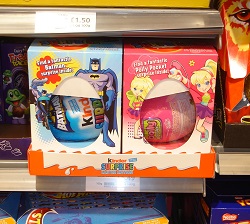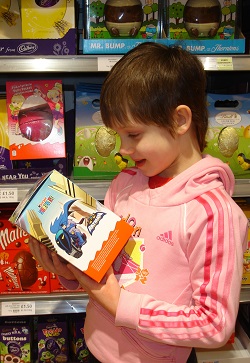Lego in pink, Barbie in blue
Or would you like a Snow White costume for your son?
 This incident took place a few years ago but stuck in my mind and I remembered it as the backlash about ‘gendered toys’ is gathering pace in the UK. Kate and her husband, James, are a modern couple; she works outside the home and he knows his way round both the kitchen and the washing machine. Yet, when it came down to it, even this modern, Newish man, balked at the idea of his son playing with what he perceived as girls’ toys.
This incident took place a few years ago but stuck in my mind and I remembered it as the backlash about ‘gendered toys’ is gathering pace in the UK. Kate and her husband, James, are a modern couple; she works outside the home and he knows his way round both the kitchen and the washing machine. Yet, when it came down to it, even this modern, Newish man, balked at the idea of his son playing with what he perceived as girls’ toys.
Nowadays, the distinction between ‘girl’ toys and ‘boy’ toys is getting a little more blurred, and I do wonder whether James would have felt quite so strongly had the toy vacuum been the more masculine navy that is now starting to become available, rather than the Disney pink that characterised all domestic toys a few years ago (and still dominates today). Although several major retailers are starting to bow to public pressure (led by the campaign group Let Toys Be Toys) to stop labelling toys as girls’ or boys’, the Pink Lego Effect (recently, Lego started producing ‘girl’ versions of its popular construction toy that includes pink and pastel coloured bricks complete with curvy plastic ‘friends’ who bake, home-make, decorate, style hair and shop) is still a strong influence.
 But, the real issue is what impact ‘gendered toys’ have on children; if toy retailers make prams and science kits gender neutral, are we really going to create more female scientists and more stay at home dads? Or will the genes out, irrespective of what we encourage our kids to play with? Certainly there is plenty of anecdotal evidence that boys will often ‘masculinise’ any attempts to make them play with ‘feminine’ toys – by turning innocuous objects into guns, or by creating aggressive stories with dolls, whilst girls will often ‘feminise’ toys such as cars to give them nurturing characters and storylines. Does allowing them free reign lead to more opportunities for both genders, or just lead to gender confusion?
But, the real issue is what impact ‘gendered toys’ have on children; if toy retailers make prams and science kits gender neutral, are we really going to create more female scientists and more stay at home dads? Or will the genes out, irrespective of what we encourage our kids to play with? Certainly there is plenty of anecdotal evidence that boys will often ‘masculinise’ any attempts to make them play with ‘feminine’ toys – by turning innocuous objects into guns, or by creating aggressive stories with dolls, whilst girls will often ‘feminise’ toys such as cars to give them nurturing characters and storylines. Does allowing them free reign lead to more opportunities for both genders, or just lead to gender confusion?
My own son’s predilection for wearing a Snow White costume whilst doing a spot of pretend cooking (both his favourite pre-school activities) did not seem to lead to any confusion; at the age of six, he is now well aware that he is a boy and that there are certain expectations associated with this identity (which exclude dresses but not cooking). My daughters were encouraged to play with traditional ‘boys’ toys (see box) as many psychologists feel that the emphasis that girls’ toys tend to have on physical appearance and attractiveness can lead to an over-emphasis on these attributes over other, more cerebral qualities. Both my daughters, now teenagers, are keen on maths and science subjects. Coincidence? Not according to the Education Minister Elizabeth Truss, who recently announced that girls’ toys risk putting girls off science and maths (as reported in The Daily Telegraph January 16th 2014).

There does tend to be a feeling that ‘gendered toys’ disadvantage girls more than boys and certainly, when it is the girls whose playthings are characterised by cleaning, cooking, domestic chores and attention to beauty, it is easy to see why. It is argued by many that such toys send messages that limit the aspirations of girls, whilst boys’ toys with their emphasis on more intellectual, confidence-building or adventurous pursuits are less limiting. It has even been suggested that girls’ toys such as Barbie, Bratz and Monster High dolls, lead to such an emphasis on thinness and physical perfection, as to be contributing to eating disorders in girls at ever younger ages. Girls’ toys do have some advantages however; research suggests that they help develop emotional literacy and communication skills which boys may thus miss out on. Girls do still outperform boys in literacy and humanities (though boys outperform girls in maths and science).
As my experience with James and Kate shows, it is parents who are often reinforcing the stereotypes. One interesting study, fox example, showed that although little boys might sleep with teddy bears, parents are less likely to describe that as their favourite toy, whereas they would with their daughters.
Manufacturers and toy shops will continue to market toys that parents buy one way or another, so it is up to mums and dads to take the initiative when choosing playthings for their children. My view is to provide a mix of ‘boy’ and ‘girl’ toys for both genders and let them choose – something easier to achieve when you have different genders in your family anyway. It is probably a brave parent who buys Barbie, My Little Pony or a Disney Princess outfit specifically for their son, but there is always the possibility of a happy medium. And, if any little boy out there wants a Snow White costume, my son has finished with his now!






